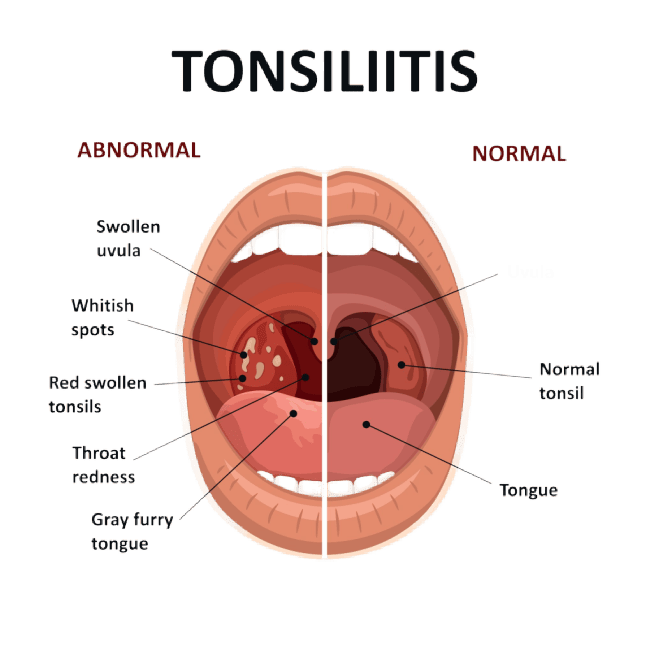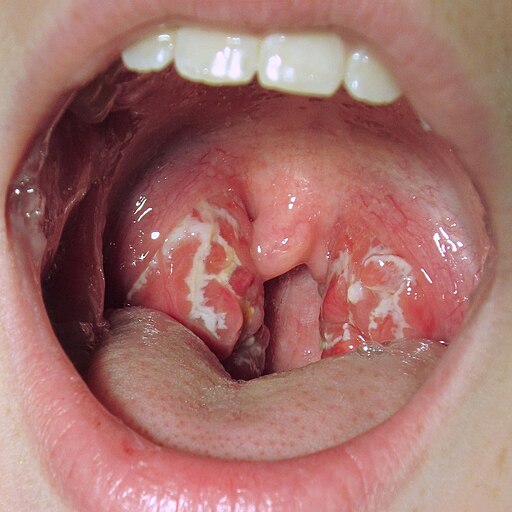 When it comes to “Strep Throat,” understanding the signs and symptoms is crucial for timely diagnosis and treatment. In this blog post, we will delve into the world of streptococcal pharyngitis, more commonly known as strep throat.
When it comes to “Strep Throat,” understanding the signs and symptoms is crucial for timely diagnosis and treatment. In this blog post, we will delve into the world of streptococcal pharyngitis, more commonly known as strep throat.
We will begin by identifying the telltale symptoms of strep throat, which can help differentiate it from other common sore throats. Next, we’ll discuss diagnostic methods such as rapid antigen tests and culture-based tests that medical professionals use to confirm a case of streptococcal infection.
Furthermore, we’ll explore effective treatments for Strep Throat when left untreated and emphasize the importance of antibiotics in managing this bacterial infection. We’ll also provide tips on ensuring comfort during recovery.
Last but not least, prevention is always better than cure; hence we will touch upon good hygiene practices and healthy lifestyle choices that contribute to a stronger immune system capable of warding off infections like strep throat. At the end, we’ll go over how to tell apart tonsillitis and strep throat by their particular signs as well as potential treatment solutions.
Table of Contents:
- Identifying Strep Throat Symptoms
- Sudden Onset Sore Throat
- Painful Swallowing
- Red and Swollen Tonsils with White Patches or Streaks of Pus
- Diagnosing Strep Throat
- Treating Strep Throat Effectively
- Home Care Tips for Treating Strep Throat
- Preventing Strep Throat
- Tonsillitis vs. Strep Throat: Spot the Difference
- FAQs in Relation to Strep Throat: What it Looks Like
- Conclusion
Identifying Strep Throat Symptoms
Recognizing the symptoms of strep throat is crucial for timely treatment and recovery.
Common signs include a sudden onset sore throat, painful swallowing, red and swollen tonsils with white patches or streaks of pus, tiny red spots on the roof of the mouth, fever, headache, nausea or vomiting (especially in younger children), body aches and rash.
Sudden Onset Sore Throat
A key indicator that differentiates strep throat from other sore throats is its abrupt onset.
This means that you may feel fine one moment and suddenly experience severe throat pain within hours.
Painful Swallowing
In addition to a sore throat, those suffering from streptococcal pharyngitis often find it difficult to swallow due to inflammation caused by the bacterial infection.
Drinking liquids can become uncomfortable as well.
Red and Swollen Tonsils with White Patches or Streaks of Pus
- Tonsil swelling: Strep throat can cause your tonsils to become enlarged and inflamed.
- Pus-filled pockets: White patches or streaks may appear on your tonsils as a result of streptococcal infections.
- Rapid detection tests: If you suspect strep throat, it’s important to visit a healthcare provider who can perform a throat culture or rapid antigen test to confirm the diagnosis and begin appropriate treatment.
By understanding these key symptoms of strep throat, you’ll be better equipped to seek prompt medical attention if necessary.
This will help prevent potential complications such as rheumatic fever or peritonsillar abscess that may arise from untreated bacterial infections.
Diagnosing Strep Throat
Got a sore throat? Your healthcare provider will likely perform a rapid antigen test to confirm if it’s strep throat, a bacterial infection caused by streptococcal bacteria.
Rapid Antigen Test
A quick swab of your throat can detect proteins from the bacteria, allowing for prompt treatment and reducing the risk of complications like rheumatic fever or kidney damage.
Culture-Based Tests When Needed
If the rapid test is negative but your healthcare provider still suspects a bacterial infection, they may order a throat culture to grow bacteria in a lab for further analysis.
Left untreated, strep throat can lead to serious complications, so accurate diagnosis is crucial. Accurately distinguishing between bacterial and viral infections is essential in order to effectively treat the underlying cause.
Don’t ignore symptoms like white patches or respiratory droplets; get tested and treated to prevent peritonsillar abscess or other complications.
Treating Strep Throat Effectively
Antibiotics are prescribed to treat strep throat infection efficiently while preventing complications such as rheumatic fever or kidney damage.
Complete the entire course of medication to prevent recurrence and resistance to future treatments.
Stopping antibiotics prematurely may contribute to antibiotic resistance, making it harder for medications to work effectively against infections in the future.
Regular check-ins with your healthcare provider will help monitor progress during recovery and address any potential concerns or complications arising from untreated streptococcal infections.
Ensure ample rest during recovery; this allows your body time needed healing itself properly minimizing risk further health problems down line including peritonsillar abscess formation among others.
Adhering to these guidelines can aid in treating strep throat and lessen the chance of issues arising.
Remember that early intervention is key in managing this bacterial infection and preventing more severe health issues from developing.
Home Care Tips for Treating Strep Throat
As a caregiver, you are instrumental in helping your loved one recover from streptococcal pharyngitis by providing soft foods such as mashed potatoes and creamy soups, along with soothing liquids like warm tea and broth. Soft foods like mashed potatoes and creamy soups, along with soothing liquids such as warm tea and broth, can help alleviate pain and discomfort.
Soft Foods to Eat During Recovery
- Mashed potatoes or sweet potatoes
- Creamy soups (avoid spicy or acidic ingredients)
- Puddings, yogurts, and applesauce
- Oatmeal or other cooked cereals softened in milk or water
- Bananas and avocados
Soothing Liquids and Gargling Salt Water
Drinking plenty of fluids is crucial when recovering from strep throat. Warm beverages like herbal teas, broths, and hot water mixed with honey can help soothe painful swallowing symptoms. Gargling lukewarm saltwater several times a day may also reduce inflammation in the throat and speed up recovery time. Check out this guide on salt water gargling for more information on how to effectively use this home remedy.
Preventing Strep Throat
Good hygiene and a healthy lifestyle are key to preventing strep throat and other infections.
Wash Your Hands
Wash your hands frequently with soap and water for at least 20 seconds to reduce the spread of germs. If you can’t access soap and water, utilize a hand sanitizing product.
Boost Your Immunity
- Get enough sleep to help your immune system function properly.
- Eat a balanced diet with fruits, vegetables, lean proteins, whole grains, and low-fat dairy to support immunity.
- Exercise regularly to improve cardiovascular health and resistance to illnesses.
- Stay up-to-date on vaccinations to reduce overall risk of respiratory illnesses.
Avoid close contact with infected individuals, and don’t share personal items like toothbrushes or utensils. Cover your mouth when coughing or sneezing to prevent the spread of germs.
By taking preventive measures, you can greatly reduce the likelihood of catching strep throat and other sicknesses.
Tonsillitis vs. Strep Throat: Spot the Difference
Both tonsillitis and strep throat can cause sore throats, but they have different causes and symptoms.

Causes of Tonsillitis
- Bacterial Infection: Tonsillitis can be caused by group A Streptococcus bacteria or other types of bacteria.
- Viral Infection: Most cases of tonsillitis are caused by viruses like the common cold or flu viruses.
Differences between Tonsillitis and Strep Throat
- Lymph Node Swelling: Tonsillitis causes more pronounced swelling of lymph nodes in the neck than strep throat.
- Breathing Difficulties: Severe tonsil inflammation can cause breathing difficulties, which is not common in strep throat unless complications like a peritonsillar abscess develop.
- Rapid Antigen Test: A positive rapid antigen test confirms streptococcal infection, while negative results suggest other causes like tonsillitis.
Consult a medical professional for proper diagnosis and treatment to prevent complications and promote faster recovery.
FAQs in Relation to Strep Throat: What it Looks Like
What does strep throat usually look like?
Strep throat appears as a red, swollen throat with white patches on the tonsils caused by the Streptococcus bacteria.
What does strep throat look like compared to normal?
A normal, healthy throat has pinkish tissue without swelling or white patches, while strep throat presents with inflamed, reddened tissue and distinct white spots on the tonsils.
Can you visually see strep throat?
You can often identify signs of strep throat by examining your mouth for redness, swelling, and white patches on your tonsils using a flashlight or mirror.
What shape is the streptococcus bacteria?
The term “streptococcus” refers to a group of spherical-shaped bacteria responsible for causing various infections including strep throat.
Conclusion
The sudden onset of a sore throat, painful swallowing, and red and swollen tonsils with white patches are telltale signs.
Diagnosing Strep Throat: Rapid antigen tests are conducted initially, followed by culture-based tests when suspicion remains high.
Treating Strep Throat: Antibiotics are crucial for treatment, along with ensuring comfort during recovery.
Preventing Strep Throat: Good hygiene practices and healthy lifestyle choices can boost immunity and prevent infections.
Tonsillitis vs. Strep Throat: Differentiating between the two is important, as unique symptoms of tonsillitis require different treatment options based on the cause.

